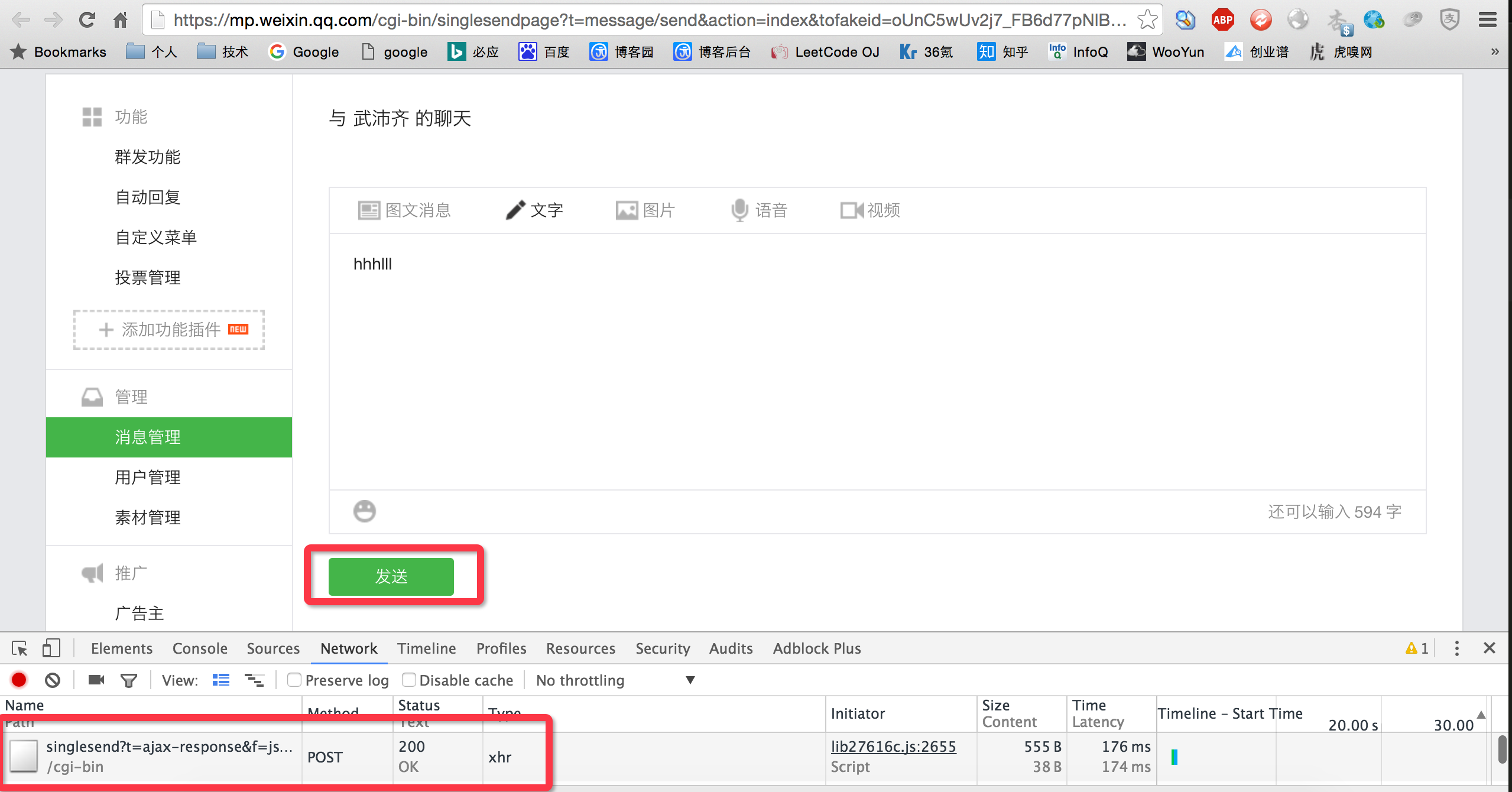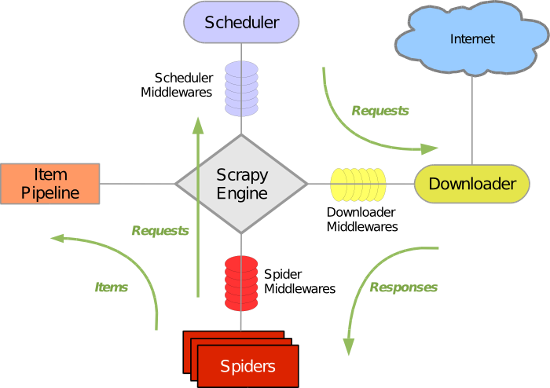网络爬虫(又被称为网页蜘蛛,网络机器人,在FOAF社区中间,更经常的称为网页追逐者),是一种按照一定的规则,自动地抓取万维网信息的程序或者脚本。另外一些不常使用的名字还有蚂蚁、自动索引、模拟程序或者蠕虫。
Requests
Python标准库中提供了:urllib、urllib2、httplib等模块以供Http请求,但是,它的 API 太渣了。它是为另一个时代、另一个互联网所创建的。它需要巨量的工作,甚至包括各种方法覆盖,来完成最简单的任务。


import urllib2 import json import cookielibdef urllib2_request(url, method="GET", cookie="", headers={}, data=None):""":param url: 要请求的url:param cookie: 请求方式,GET、POST、DELETE、PUT..:param cookie: 要传入的cookie,cookie= 'k1=v1;k1=v2':param headers: 发送数据时携带的请求头,headers = {'ContentType':'application/json; charset=UTF-8'}:param data: 要发送的数据GET方式需要传入参数,data={'d1': 'v1'}:return: 返回元祖,响应的字符串内容 和 cookiejar对象对于cookiejar对象,可以使用for循环访问:for item in cookiejar:print item.name,item.value"""if data:data = json.dumps(data)cookie_jar = cookielib.CookieJar()handler = urllib2.HTTPCookieProcessor(cookie_jar)opener = urllib2.build_opener(handler)opener.addheaders.append(['Cookie', 'k1=v1;k1=v2'])request = urllib2.Request(url=url, data=data, headers=headers)request.get_method = lambda: methodresponse = opener.open(request)origin = response.read()return origin, cookie_jar# GET result = urllib2_request('http://127.0.0.1:8001/index/', method="GET")# POST result = urllib2_request('http://127.0.0.1:8001/index/', method="POST", data= {'k1': 'v1'})# PUT result = urllib2_request('http://127.0.0.1:8001/index/', method="PUT", data= {'k1': 'v1'})
Requests 是使用 Apache2 Licensed 许可证的 基于Python开发的HTTP 库,其在Python内置模块的基础上进行了高度的封装,从而使得Pythoner进行网络请求时,变得美好了许多,使用Requests可以轻而易举的完成浏览器可有的任何操作。
1、GET请求
# 1、无参数实例import requestsret = requests.get('https://github.com/timeline.json')print ret.url print ret.text# 2、有参数实例import requestspayload = {'key1': 'value1', 'key2': 'value2'} ret = requests.get("http://httpbin.org/get", params=payload)print ret.url print ret.text
向 https://github.com/timeline.json 发送一个GET请求,将请求和响应相关均封装在 ret 对象中。
2、POST请求
# 1、基本POST实例import requestspayload = {'key1': 'value1', 'key2': 'value2'} ret = requests.post("http://httpbin.org/post", data=payload)print ret.text# 2、发送请求头和数据实例import requests import jsonurl = 'https://api.github.com/some/endpoint' payload = {'some': 'data'} headers = {'content-type': 'application/json'}ret = requests.post(url, data=json.dumps(payload), headers=headers)print ret.text print ret.cookies
向https://api.github.com/some/endpoint发送一个POST请求,将请求和相应相关的内容封装在 ret 对象中。
3、其他请求
requests.get(url, params=None, **kwargs) requests.post(url, data=None, json=None, **kwargs) requests.put(url, data=None, **kwargs) requests.head(url, **kwargs) requests.delete(url, **kwargs) requests.patch(url, data=None, **kwargs) requests.options(url, **kwargs)# 以上方法均是在此方法的基础上构建 requests.request(method, url, **kwargs)
requests模块已经将常用的Http请求方法为用户封装完成,用户直接调用其提供的相应方法即可,其中方法的所有参数有:


def request(method, url, **kwargs):"""Constructs and sends a :class:`Request <Request>`.:param method: method for the new :class:`Request` object.:param url: URL for the new :class:`Request` object.:param params: (optional) Dictionary or bytes to be sent in the query string for the :class:`Request`.:param data: (optional) Dictionary, bytes, or file-like object to send in the body of the :class:`Request`.:param json: (optional) json data to send in the body of the :class:`Request`.:param headers: (optional) Dictionary of HTTP Headers to send with the :class:`Request`.:param cookies: (optional) Dict or CookieJar object to send with the :class:`Request`.:param files: (optional) Dictionary of ``'name': file-like-objects`` (or ``{'name': ('filename', fileobj)}``) for multipart encoding upload.:param auth: (optional) Auth tuple to enable Basic/Digest/Custom HTTP Auth.:param timeout: (optional) How long to wait for the server to send databefore giving up, as a float, or a :ref:`(connect timeout, readtimeout) <timeouts>` tuple.:type timeout: float or tuple:param allow_redirects: (optional) Boolean. Set to True if POST/PUT/DELETE redirect following is allowed.:type allow_redirects: bool:param proxies: (optional) Dictionary mapping protocol to the URL of the proxy.:param verify: (optional) whether the SSL cert will be verified. A CA_BUNDLE path can also be provided. Defaults to ``True``.:param stream: (optional) if ``False``, the response content will be immediately downloaded.:param cert: (optional) if String, path to ssl client cert file (.pem). If Tuple, ('cert', 'key') pair.:return: :class:`Response <Response>` object:rtype: requests.ResponseUsage::>>> import requests>>> req = requests.request('GET', 'http://httpbin.org/get')<Response [200]>"""# By using the 'with' statement we are sure the session is closed, thus we# avoid leaving sockets open which can trigger a ResourceWarning in some# cases, and look like a memory leak in others. with sessions.Session() as session:return session.request(method=method, url=url, **kwargs)


### 1、首先登陆任何页面,获取cookie i1 = requests.get(url= "http://dig.chouti.com/help/service")### 2、用户登陆,携带上一次的cookie,后台对cookie中的 gpsd 进行授权 i2 = requests.post(url= "http://dig.chouti.com/login",data= {'phone': "86手机号",'password': "密码",'oneMonth': ""},cookies = i1.cookies.get_dict() )### 3、点赞(只需要携带已经被授权的gpsd即可) gpsd = i1.cookies.get_dict()['gpsd'] i3 = requests.post(url="http://dig.chouti.com/link/vote?linksId=8589523",cookies={'gpsd': gpsd} ) print(i3.text)
“破解”微信公众号
“破解”微信公众号其实就是使用Python代码自动实现【登陆公众号】->【获取观众用户】-> 【向关注用户发送消息】。
注:只能向48小时内有互动的粉丝主动推送消息
1、自动登陆

分析对于Web登陆页面,用户登陆验证时仅做了如下操作:
- 登陆的URL:https://mp.weixin.qq.com/cgi-bin/login?lang=zh_CN
- POST的数据为:
{
'username': 用户名,
'pwd': 密码的MD5值,
'imgcode': "",
'f': 'json'
}
注:imgcode是需要提供的验证码,默认无需验证码,只有在多次登陆未成功时,才需要用户提供验证码才能登陆 - POST的请求头的Referer值,微信后台用次来检查是谁发送来的请求
- 请求发送并登陆成功后,获取用户响应的cookie,以后操作其他页面时需要携带此cookie
- 请求发送并登陆成功后,获取用户相应的内容中的token


import requests import time import hashlibdef _password(pwd):ha = hashlib.md5()ha.update(pwd)return ha.hexdigest()def login():login_dict = {'username': "用户名",'pwd': _password("密码"),'imgcode': "",'f': 'json'}login_res = requests.post(url= "https://mp.weixin.qq.com/cgi-bin/login?lang=zh_CN",data=login_dict,headers={'Referer': 'https://mp.weixin.qq.com/cgi-bin/login?lang=zh_CN'})# 登陆成功之后获取服务器响应的cookieresp_cookies_dict = login_res.cookies.get_dict()# 登陆成功后,获取服务器响应的内容resp_text = login_res.text# 登陆成功后,获取tokentoken = re.findall(".*token=(\d+)", resp_text)[0]print resp_textprint tokenprint resp_cookies_dictlogin()
登陆成功获取的相应内容如下:
响应内容: {"base_resp":{"ret":0,"err_msg":"ok"},"redirect_url":"\/cgi-bin\/home?t=home\/index&lang=zh_CN&token=537908795"}响应cookie: {'data_bizuin': '3016804678', 'bizuin': '3016804678', 'data_ticket': 'CaoX+QA0ZA9LRZ4YM3zZkvedyCY8mZi0XlLonPwvBGkX0/jY/FZgmGTq6xGuQk4H', 'slave_user': 'gh_5abeaed48d10', 'slave_sid': 'elNLbU1TZHRPWDNXSWdNc2FjckUxalM0Y000amtTamlJOUliSnRnWGRCdjFseV9uQkl5cUpHYkxqaGJNcERtYnM2WjdFT1pQckNwMFNfUW5fUzVZZnFlWGpSRFlVRF9obThtZlBwYnRIVGt6cnNGbUJsNTNIdTlIc2JJU29QM2FPaHZjcTcya0F6UWRhQkhO'}
2、访问其他页面获取用户信息
分析用户管理页面,通过Pyhton代码以Get方式访问此页面,分析响应到的 HTML 代码,从中获取用户信息:
- 获取用户的URL:https://mp.weixin.qq.com/cgi-bin/user_tag?action=get_all_data&lang=zh_CN&token=登陆时获取的token
- 发送GET请求时,需要携带登陆成功后获取的cookie
-
{'data_bizuin': '3016804678', 'bizuin': '3016804678', 'data_ticket': 'C4YM3zZ... - 获取当前请求的响应的html代码
- 通过正则表达式获取html中的指定内容(Python的模块Beautiful Soup)
- 获取html中每个用户的 data-fakeid属性,该值是用户的唯一标识,通过它可向用户推送消息
-

 代码实现
代码实现import requests import time import hashlib import json import reLOGIN_COOKIES_DICT = {}def _password(pwd):ha = hashlib.md5()ha.update(pwd)return ha.hexdigest()def login():login_dict = {'username': "用户名",'pwd': _password("密码"),'imgcode': "",'f': 'json'}login_res = requests.post(url= "https://mp.weixin.qq.com/cgi-bin/login?lang=zh_CN",data=login_dict,headers={'Referer': 'https://mp.weixin.qq.com/cgi-bin/login?lang=zh_CN'})# 登陆成功之后获取服务器响应的cookieresp_cookies_dict = login_res.cookies.get_dict()# 登陆成功后,获取服务器响应的内容resp_text = login_res.text# 登陆成功后,获取tokentoken = re.findall(".*token=(\d+)", resp_text)[0]return {'token': token, 'cookies': resp_cookies_dict}def standard_user_list(content):content = re.sub('\s*', '', content)content = re.sub('\n*', '', content)data = re.findall("""cgiData=(.*);seajs""", content)[0]data = data.strip()while True:temp = re.split('({)(\w+)(:)', data, 1)if len(temp) == 5:temp[2] = '"' + temp[2] + '"'data = ''.join(temp)else:breakwhile True:temp = re.split('(,)(\w+)(:)', data, 1)if len(temp) == 5:temp[2] = '"' + temp[2] + '"'data = ''.join(temp)else:breakdata = re.sub('\*\d+', "", data)ret = json.loads(data)return retdef get_user_list():login_dict = login()LOGIN_COOKIES_DICT.update(login_dict)login_cookie_dict = login_dict['cookies']res_user_list = requests.get(url= "https://mp.weixin.qq.com/cgi-bin/user_tag",params = {"action": "get_all_data", "lang": "zh_CN", "token": login_dict['token']},cookies = login_cookie_dict,headers={'Referer': 'https://mp.weixin.qq.com/cgi-bin/login?lang=zh_CN'})user_info = standard_user_list(res_user_list.text)for item in user_info['user_list']:print "%s %s " % (item['nick_name'],item['id'],)get_user_list()
3、发送消息

分析给用户发送消息的页面,从网络请求中剖析得到发送消息的URL,从而使用Python代码发送消息:
- 发送消息的URL:https://mp.weixin.qq.com/cgi-bin/singlesend?t=ajax-response&f=json&token=登陆时获取的token放在此处&lang=zh_CN
- 从登陆时相应的内容中获取:token和cookie
- 从用户列表中获取某个用户唯一标识: fake_id
- 封装消息,并发送POST请求
-
send_dict = {'token': 登陆时获取的token,'lang': "zh_CN",'f': 'json','ajax': 1,'random': "0.5322618900912392",'type': 1,'content': 要发送的内容,'tofakeid': 用户列表中获取的用户的ID,'imgcode': '' }

 发送消息代码
发送消息代码import requests import time import hashlib import json import reLOGIN_COOKIES_DICT = {}def _password(pwd):ha = hashlib.md5()ha.update(pwd)return ha.hexdigest()def login():login_dict = {'username': "用户名",'pwd': _password("密码"),'imgcode': "",'f': 'json'}login_res = requests.post(url= "https://mp.weixin.qq.com/cgi-bin/login?lang=zh_CN",data=login_dict,headers={'Referer': 'https://mp.weixin.qq.com/cgi-bin/login?lang=zh_CN'})# 登陆成功之后获取服务器响应的cookieresp_cookies_dict = login_res.cookies.get_dict()# 登陆成功后,获取服务器响应的内容resp_text = login_res.text# 登陆成功后,获取tokentoken = re.findall(".*token=(\d+)", resp_text)[0]return {'token': token, 'cookies': resp_cookies_dict}def standard_user_list(content):content = re.sub('\s*', '', content)content = re.sub('\n*', '', content)data = re.findall("""cgiData=(.*);seajs""", content)[0]data = data.strip()while True:temp = re.split('({)(\w+)(:)', data, 1)if len(temp) == 5:temp[2] = '"' + temp[2] + '"'data = ''.join(temp)else:breakwhile True:temp = re.split('(,)(\w+)(:)', data, 1)if len(temp) == 5:temp[2] = '"' + temp[2] + '"'data = ''.join(temp)else:breakdata = re.sub('\*\d+', "", data)ret = json.loads(data)return retdef get_user_list():login_dict = login()LOGIN_COOKIES_DICT.update(login_dict)login_cookie_dict = login_dict['cookies']res_user_list = requests.get(url= "https://mp.weixin.qq.com/cgi-bin/user_tag",params = {"action": "get_all_data", "lang": "zh_CN", "token": login_dict['token']},cookies = login_cookie_dict,headers={'Referer': 'https://mp.weixin.qq.com/cgi-bin/login?lang=zh_CN'})user_info = standard_user_list(res_user_list.text)for item in user_info['user_list']:print "%s %s " % (item['nick_name'],item['id'],)def send_msg(user_fake_id, content='啥也没发'):login_dict = LOGIN_COOKIES_DICTtoken = login_dict['token']login_cookie_dict = login_dict['cookies']send_dict = {'token': token,'lang': "zh_CN",'f': 'json','ajax': 1,'random': "0.5322618900912392",'type': 1,'content': content,'tofakeid': user_fake_id,'imgcode': ''}send_url = "https://mp.weixin.qq.com/cgi-bin/singlesend?t=ajax-response&f=json&token=%s&lang=zh_CN" % (token,)message_list = requests.post(url=send_url, data=send_dict, cookies=login_cookie_dict, headers={'Referer': 'https://mp.weixin.qq.com/cgi-bin/login?lang=zh_CN'})get_user_list() fake_id = raw_input('请输入用户ID:') content = raw_input('请输入消息内容:') send_msg(fake_id, content)
以上就是“破解”微信公众号的整个过程,通过Python代码实现了自动【登陆微信公众号平台】【获取用户列表】【指定用户发送消息】。
Scrapy
Scrapy是一个为了爬取网站数据,提取结构性数据而编写的应用框架。 其可以应用在数据挖掘,信息处理或存储历史数据等一系列的程序中。
其最初是为了页面抓取 (更确切来说, 网络抓取 )所设计的, 也可以应用在获取API所返回的数据(例如 Amazon Associates Web Services ) 或者通用的网络爬虫。Scrapy用途广泛,可以用于数据挖掘、监测和自动化测试。
Scrapy 使用了 Twisted异步网络库来处理网络通讯。整体架构大致如下

Scrapy主要包括了以下组件:
- 引擎(Scrapy)
用来处理整个系统的数据流处理, 触发事务(框架核心) - 调度器(Scheduler)
用来接受引擎发过来的请求, 压入队列中, 并在引擎再次请求的时候返回. 可以想像成一个URL(抓取网页的网址或者说是链接)的优先队列, 由它来决定下一个要抓取的网址是什么, 同时去除重复的网址 - 下载器(Downloader)
用于下载网页内容, 并将网页内容返回给蜘蛛(Scrapy下载器是建立在twisted这个高效的异步模型上的) - 爬虫(Spiders)
爬虫是主要干活的, 用于从特定的网页中提取自己需要的信息, 即所谓的实体(Item)。用户也可以从中提取出链接,让Scrapy继续抓取下一个页面 - 项目管道(Pipeline)
负责处理爬虫从网页中抽取的实体,主要的功能是持久化实体、验证实体的有效性、清除不需要的信息。当页面被爬虫解析后,将被发送到项目管道,并经过几个特定的次序处理数据。 - 下载器中间件(Downloader Middlewares)
位于Scrapy引擎和下载器之间的框架,主要是处理Scrapy引擎与下载器之间的请求及响应。 - 爬虫中间件(Spider Middlewares)
介于Scrapy引擎和爬虫之间的框架,主要工作是处理蜘蛛的响应输入和请求输出。 - 调度中间件(Scheduler Middewares)
介于Scrapy引擎和调度之间的中间件,从Scrapy引擎发送到调度的请求和响应。
Scrapy运行流程大概如下:
- 引擎从调度器中取出一个链接(URL)用于接下来的抓取
- 引擎把URL封装成一个请求(Request)传给下载器
- 下载器把资源下载下来,并封装成应答包(Response)
- 爬虫解析Response
- 解析出实体(Item),则交给实体管道进行进一步的处理
- 解析出的是链接(URL),则把URL交给调度器等待抓取
一、安装
pip install Scrapy
注:windows平台需要依赖pywin32,请根据自己系统32/64位选择下载安装,https://sourceforge.net/projects/pywin32/
二、基本使用
1、创建项目
运行命令:
scrapy startproject your_project_name
自动创建目录:
project_name/scrapy.cfgproject_name/__init__.pyitems.pypipelines.pysettings.pyspiders/__init__.py
文件说明:
- scrapy.cfg 项目的配置信息,主要为Scrapy命令行工具提供一个基础的配置信息。(真正爬虫相关的配置信息在settings.py文件中)
- items.py 设置数据存储模板,用于结构化数据,如:Django的Model
- pipelines 数据处理行为,如:一般结构化的数据持久化
- settings.py 配置文件,如:递归的层数、并发数,延迟下载等
- spiders 爬虫目录,如:创建文件,编写爬虫规则
注意:一般创建爬虫文件时,以网站域名命名
2、编写爬虫
在spiders目录中新建 xiaohuar_spider.py 文件


import scrapyclass XiaoHuarSpider(scrapy.spiders.Spider):name = "xiaohuar"allowed_domains = ["xiaohuar.com"]start_urls = ["http://www.xiaohuar.com/hua/",]def parse(self, response):# print(response, type(response))# from scrapy.http.response.html import HtmlResponse# print(response.body_as_unicode()) current_url = response.urlbody = response.bodyunicode_body = response.body_as_unicode()
3、运行
进入project_name目录,运行命令
scrapy crawl spider_name --nolog
4、递归的访问
以上的爬虫仅仅是爬去初始页,而我们爬虫是需要源源不断的执行下去,直到所有的网页被执行完毕
import scrapy from scrapy.http import Request from scrapy.selector import HtmlXPathSelector import re import urllib import osclass XiaoHuarSpider(scrapy.spiders.Spider):name = "xiaohuar"allowed_domains = ["xiaohuar.com"]start_urls = ["http://www.xiaohuar.com/list-1-1.html",]def parse(self, response):# 分析页面# 找到页面中符合规则的内容(校花图片),保存# 找到所有的a标签,再访问其他a标签,一层一层的搞下去 hxs = HtmlXPathSelector(response)# 如果url是 http://www.xiaohuar.com/list-1-\d+.htmlif re.match('http://www.xiaohuar.com/list-1-\d+.html', response.url):items = hxs.select('//div[@class="item_list infinite_scroll"]/div')for i in range(len(items)):src = hxs.select('//div[@class="item_list infinite_scroll"]/div[%d]//div[@class="img"]/a/img/@src' % i).extract()name = hxs.select('//div[@class="item_list infinite_scroll"]/div[%d]//div[@class="img"]/span/text()' % i).extract()school = hxs.select('//div[@class="item_list infinite_scroll"]/div[%d]//div[@class="img"]/div[@class="btns"]/a/text()' % i).extract()if src:ab_src = "http://www.xiaohuar.com" + src[0]file_name = "%s_%s.jpg" % (school[0].encode('utf-8'), name[0].encode('utf-8'))file_path = os.path.join("/Users/wupeiqi/PycharmProjects/beauty/pic", file_name)urllib.urlretrieve(ab_src, file_path)# 获取所有的url,继续访问,并在其中寻找相同的urlall_urls = hxs.select('//a/@href').extract()for url in all_urls:if url.startswith('http://www.xiaohuar.com/list-1-'):yield Request(url, callback=self.parse)
以上代码将符合规则的页面中的图片保存在指定目录,并且在HTML源码中找到所有的其他 a 标签的href属性,从而“递归”的执行下去,直到所有的页面都被访问过为止。以上代码之所以可以进行“递归”的访问相关URL,关键在于parse方法使用了 yield Request对象。
注:可以修改settings.py 中的配置文件,以此来指定“递归”的层数,如: DEPTH_LIMIT = 1


from scrapy.selector import Selector from scrapy.http import HtmlResponse html = """<!DOCTYPE html> <html> <head lang="en"><meta charset="UTF-8"><title></title> </head> <body><li class="item-"><a href="link.html">first item</a></li><li class="item-0"><a href="link1.html">first item</a></li><li class="item-1"><a href="link2.html">second item</a></li> </body> </html> """ response = HtmlResponse(url='http://example.com', body=html,encoding='utf-8') ret = Selector(response=response).xpath('//li[re:test(@class, "item-\d*")]//@href').extract() print(ret)


import scrapy import hashlib from tutorial.items import JinLuoSiItem from scrapy.http import Request from scrapy.selector import HtmlXPathSelectorclass JinLuoSiSpider(scrapy.spiders.Spider):count = 0url_set = set()name = "jluosi"domain = 'http://www.jluosi.com'allowed_domains = ["jluosi.com"]start_urls = ["http://www.jluosi.com:80/ec/goodsDetail.action?jls=QjRDNEIzMzAzOEZFNEE3NQ==",]def parse(self, response):md5_obj = hashlib.md5()md5_obj.update(response.url)md5_url = md5_obj.hexdigest()if md5_url in JinLuoSiSpider.url_set:passelse:JinLuoSiSpider.url_set.add(md5_url)hxs = HtmlXPathSelector(response)if response.url.startswith('http://www.jluosi.com:80/ec/goodsDetail.action'):item = JinLuoSiItem()item['company'] = hxs.select('//div[@class="ShopAddress"]/ul/li[1]/text()').extract()item['link'] = hxs.select('//div[@class="ShopAddress"]/ul/li[2]/text()').extract()item['qq'] = hxs.select('//div[@class="ShopAddress"]//a/@href').re('.*uin=(?P<qq>\d*)&')item['address'] = hxs.select('//div[@class="ShopAddress"]/ul/li[4]/text()').extract()item['title'] = hxs.select('//h1[@class="goodsDetail_goodsName"]/text()').extract()item['unit'] = hxs.select('//table[@class="R_WebDetail_content_tab"]//tr[1]//td[3]/text()').extract()product_list = []product_tr = hxs.select('//table[@class="R_WebDetail_content_tab"]//tr')for i in range(2,len(product_tr)):temp = {'standard':hxs.select('//table[@class="R_WebDetail_content_tab"]//tr[%d]//td[2]/text()' %i).extract()[0].strip(),'price':hxs.select('//table[@class="R_WebDetail_content_tab"]//tr[%d]//td[3]/text()' %i).extract()[0].strip(),}product_list.append(temp)item['product_list'] = product_listyield itemcurrent_page_urls = hxs.select('//a/@href').extract()for i in range(len(current_page_urls)):url = current_page_urls[i]if url.startswith('http://www.jluosi.com'):url_ab = urlyield Request(url_ab, callback=self.parse)


def parse(self, response):from scrapy.http.cookies import CookieJarcookieJar = CookieJar()cookieJar.extract_cookies(response, response.request)print(cookieJar._cookies)
5、格式化处理
上述实例只是简单的图片处理,所以在parse方法中直接处理。如果对于想要获取更多的数据(获取页面的价格、商品名称、QQ等),则可以利用Scrapy的items将数据格式化,然后统一交由pipelines来处理。
在items.py中创建类:
# Define here the models for your scraped items # # See documentation in: # http://doc.scrapy.org/en/latest/topics/items.htmlimport scrapyclass JieYiCaiItem(scrapy.Item):company = scrapy.Field()title = scrapy.Field()qq = scrapy.Field()info = scrapy.Field()more = scrapy.Field()
上述定义模板,以后对于从请求的源码中获取的数据同意按照此结构来获取,所以在spider中需要有一下操作:


import scrapy import hashlib from beauty.items import JieYiCaiItem from scrapy.http import Request from scrapy.selector import HtmlXPathSelector from scrapy.spiders import CrawlSpider, Rule from scrapy.linkextractors import LinkExtractorclass JieYiCaiSpider(scrapy.spiders.Spider):count = 0url_set = set()name = "jieyicai"domain = 'http://www.jieyicai.com'allowed_domains = ["jieyicai.com"]start_urls = ["http://www.jieyicai.com",]rules = [#下面是符合规则的网址,但是不抓取内容,只是提取该页的链接(这里网址是虚构的,实际使用时请替换)#Rule(SgmlLinkExtractor(allow=(r'http://test_url/test?page_index=\d+'))),#下面是符合规则的网址,提取内容,(这里网址是虚构的,实际使用时请替换)#Rule(LinkExtractor(allow=(r'http://www.jieyicai.com/Product/Detail.aspx?pid=\d+')), callback="parse"), ]def parse(self, response):md5_obj = hashlib.md5()md5_obj.update(response.url)md5_url = md5_obj.hexdigest()if md5_url in JieYiCaiSpider.url_set:passelse:JieYiCaiSpider.url_set.add(md5_url)hxs = HtmlXPathSelector(response)if response.url.startswith('http://www.jieyicai.com/Product/Detail.aspx'):item = JieYiCaiItem()item['company'] = hxs.select('//span[@class="username g-fs-14"]/text()').extract()item['qq'] = hxs.select('//span[@class="g-left bor1qq"]/a/@href').re('.*uin=(?P<qq>\d*)&')item['info'] = hxs.select('//div[@class="padd20 bor1 comard"]/text()').extract()item['more'] = hxs.select('//li[@class="style4"]/a/@href').extract()item['title'] = hxs.select('//div[@class="g-left prodetail-text"]/h2/text()').extract()yield itemcurrent_page_urls = hxs.select('//a/@href').extract()for i in range(len(current_page_urls)):url = current_page_urls[i]if url.startswith('/'):url_ab = JieYiCaiSpider.domain + urlyield Request(url_ab, callback=self.parse)
此处代码的关键在于:
- 将获取的数据封装在了Item对象中
- yield Item对象 (一旦parse中执行yield Item对象,则自动将该对象交个pipelines的类来处理)


Define your item pipelines here # # Don't forget to add your pipeline to the ITEM_PIPELINES setting # See: http://doc.scrapy.org/en/latest/topics/item-pipeline.htmlimport json from twisted.enterprise import adbapi import MySQLdb.cursors import remobile_re = re.compile(r'(13[0-9]|15[012356789]|17[678]|18[0-9]|14[57])[0-9]{8}') phone_re = re.compile(r'(\d+-\d+|\d+)')class JsonPipeline(object):def __init__(self):self.file = open('/Users/wupeiqi/PycharmProjects/beauty/beauty/jieyicai.json', 'wb')def process_item(self, item, spider):line = "%s %s\n" % (item['company'][0].encode('utf-8'), item['title'][0].encode('utf-8'))self.file.write(line)return itemclass DBPipeline(object):def __init__(self):self.db_pool = adbapi.ConnectionPool('MySQLdb',db='DbCenter',user='root',passwd='123',cursorclass=MySQLdb.cursors.DictCursor,use_unicode=True)def process_item(self, item, spider):query = self.db_pool.runInteraction(self._conditional_insert, item)query.addErrback(self.handle_error)return itemdef _conditional_insert(self, tx, item):tx.execute("select nid from company where company = %s", (item['company'][0], ))result = tx.fetchone()if result:passelse:phone_obj = phone_re.search(item['info'][0].strip())phone = phone_obj.group() if phone_obj else ' 'mobile_obj = mobile_re.search(item['info'][1].strip())mobile = mobile_obj.group() if mobile_obj else ' 'values = (item['company'][0],item['qq'][0],phone,mobile,item['info'][2].strip(),item['more'][0])tx.execute("insert into company(company,qq,phone,mobile,address,more) values(%s,%s,%s,%s,%s,%s)", values)def handle_error(self, e):print('error',e)
上述中的pipelines中有多个类,到底Scapy会自动执行那个?哈哈哈哈,当然需要先配置了,不然Scapy就蒙逼了。。。
在settings.py中做如下配置:
ITEM_PIPELINES = {'beauty.pipelines.DBPipeline': 300,'beauty.pipelines.JsonPipeline': 100, } # 每行后面的整型值,确定了他们运行的顺序,item按数字从低到高的顺序,通过pipeline,通常将这些数字定义在0-1000范围内。








)




)

的问题)
类软件收集(偶尔更新列表))

)
)